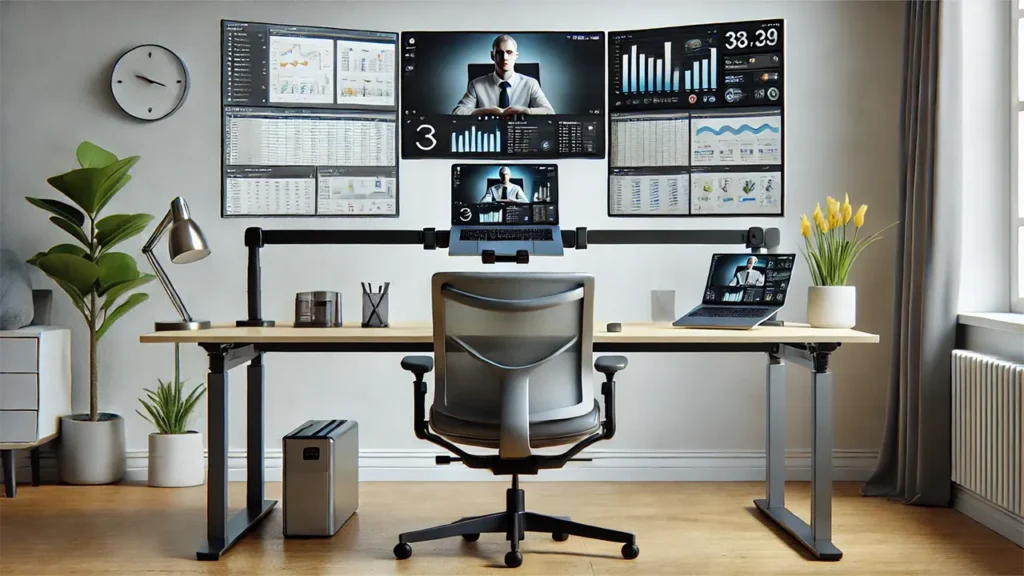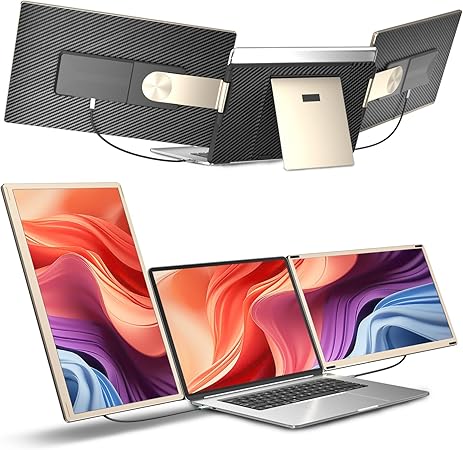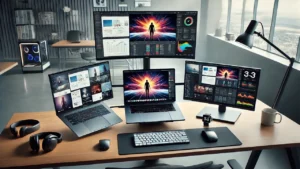Let’s face it – working on a laptop can be a pain when you’re juggling multiple tasks. One screen just doesn’t cut it. Enter laptop screen extenders.
They let you expand your screen real estate, so you don’t have to keep flipping between tabs or straining your eyes trying to make sense of tiny fonts.
But here’s the catch: there are two kinds. Portable and stationary.
So, which one should you pick? Well, let’s dive into both types and break it down.
What’s the Deal with Stationary Laptop Screen Extenders?
Stationary laptop screen extenders are those that stay put on your desk or workspace. These aren’t the clip-on ones that you can easily pack in your bag. These are typically larger, more stable setups designed to provide a more permanent, multi-monitor workspace.
If you’re working at home or in a fixed spot like an office, this could be the setup for you.
Stationary extenders offer a more expansive view, helping you get through your tasks without constantly switching between windows. They often come in larger screen sizes compared to portable extenders.
Some popular setups include triple-screen extenders, like the Siaviala S6, where you get two additional screens on either side of your laptop, giving you a full three-screen experience. Pretty neat for anyone who’s got a lot going on!
Looking to enhance your setup with a portable display? Our Ultimate Guide to Portable Monitors offers in-depth reviews and recommendations to help you make an informed decision.
Key Features of the Siaviala 15.6-Inch Portable Monitor:
Wide Compatibility: Supports multiple devices, including Android phones, Windows, Mac OS, Linux, Xbox, Switch, PlayStation 4/5, and other platforms.
Ultra-Slim and Lightweight Design: The portable monitor features a sleek and lightweight build, making it easy to carry for travel and enhancing productivity on the go.
Full HD Display: Equipped with a 15.6-inch FHD (1920x1080) IPS screen, it offers vivid colors and sharp visuals for a superior viewing experience.
- Broad device compatibility for various operating systems and consoles.
- Lightweight and portable design ideal for travel or work on the go.
- Plug-and-play setup eliminates the need for additional drivers.
- Slightly heavier than other portable monitors in its class (5.26 lbs).
- Limited brightness (300 nits) may not perform well in brightly lit environments.
- Requires a hub for compatibility with some laptops or systems.
Portable vs. Stationary: What’s the Difference?
Let’s compare the two, and I’ll tell you exactly where each one shines.
1. Portability
- Portable extenders are all about the hustle. Lightweight, compact, and easy to take anywhere.
- Stationary extenders are big, bulky, and made for staying in one place. You won’t be carrying these around.
For those who work on the move, a portable screen extender is an essential companion. But if you’re at a fixed desk, you can go all in with a stationary one.
2. Screen Real Estate
- Portable screen extenders are usually smaller and may only give you one extra screen.
- In contrast, stationary models are designed for durability and long-term use. Think triple-monitor setups that give you all the screen space you could need.
For heavy multitaskers or creatives like video editors, stationary extenders are a no-brainer. They’re the perfect setup for organising your workspace without feeling cramped.
3. Setup Time
- Portable ones are quick to set up – clip it on, plug it in, and you’re good to go.
- Stationary extenders might require a bit more effort. You’ll need to arrange your desk space and connect multiple monitors, but the results are worth it.
If you’re after simplicity, go portable. If you want the ultimate workstation, invest some time in setting up a stationary extender.
4. Ergonomics
- A bigger screen setup = less squinting, better posture, and less neck strain.
- Portable extenders are small, which means you’ll still be looking at your laptop’s screen for certain tasks, which might not be as comfy.
Stationary setups allow you to get those screens at eye level, and your back and neck will thank you after hours of work.
What Should You Look for in a Stationary Laptop Screen Extender ?
Now that we’ve got a better idea of the differences, let’s talk about what makes a good stationary
- Compatibility: Make sure the extender works with your laptop’s operating system. Some may be designed for MacBooks, while others are built with Windows laptops in mind.
- Portability (if needed): Some stationary extenders are still fairly portable. If you need to move your setup now and then, look for something that’s easy to detach and relocate.
- Display Quality: The bigger the screen, the better the quality should be. Look for high resolution (at least 1080p) and decent brightness so you don’t end up straining your eyes.
You can check out reviews of the top 5 laptop screen extenders to find a reliable option for your needs.
Benefits of Using a Stationary Laptop Screen Extender
Let’s take a quick look at the big wins of using a stationary extender. These benefits are designed to streamline and enhance your work life:
- Increased Productivity – More screen space means less flipping between windows. Get things done faster.
- Enhanced Collaboration – Easy to share your screen with others in meetings or brainstorming sessions.
- Improved Ergonomics – Keep your neck and back happy with a multi-screen setup that you can arrange however you like.
Need more screen space for coding, graphic design, or even just watching videos? Stationary extenders can give you exactly what you need to ramp up your productivity.
Considerations When Choosing a Stationary Laptop Screen Extender
Here are a few things to keep in mind when picking out your new extender:
- Port Compatibility: Make sure the extender is compatible with the ports on your laptop, whether it’s HDMI, USB-C, or something else.
- Screen Size & Resolution: Bigger is better, but make sure you’re getting a clear picture. Look for at least 1080p resolution.
- Desk Space: Stationary extenders are often large. So, make sure you have enough space on your desk to accommodate the extra screens.
Check out more about the best laptop screen extenders for every budget.
FAQs
What’s the main difference between portable and stationary extenders?
Portable extenders are lightweight and easy to carry around, whereas stationary extenders are more robust and designed to stay on your desk for a long-term setup.
How do I connect a stationary laptop screen extender ?
Most stationary extenders will connect via HDMI or USB-C. Follow the instructions included with your product to set it up.
Can a laptop screen extender improve my productivity?
Absolutely! More screen space means fewer distractions, and you can have multiple apps or windows open at once. That translates to getting more done.
Are stationary extenders good for gaming?
It depends on the model. Some extenders offer high refresh rates and low latency, which are great for gaming, while others may be better suited for work.
Ready to Choose the Right Extender?
Whether you’re looking for something portable or a stationary laptop screen extender, the right choice depends on your needs. If you’re constantly on the move, go portable. But if you’re working from a dedicated desk, a stationary setup might just be what you need to boost your productivity and comfort.
So, go ahead, explore your options, and get that extra screen space!
Check out more on the top 5 laptop screen extenders to make your choice easier.







4 thoughts on “Portable vs. Stationary: Which Laptop Screen Extender Is Right for You?”
Pingback: Top 5 Laptop Screen Extenders of 2025: A Comprehensive Review – Maximize Your Laptop Screen
Pingback: Top Arzopa Portable Monitors for Remote Work: A Comprehensive Guide
Pingback: Unlock Ultimate Productivity with a Triple Portable Monitor Setup for Your Laptop
Pingback: Top 5 Laptop Screen Extenders of 2025: A Comprehensive Review
Comments are closed.